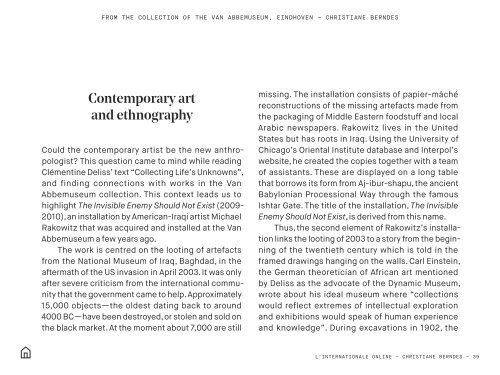DECOLONISING MUSEUMS
decolonisingmuseums_pdf-final
decolonisingmuseums_pdf-final
You also want an ePaper? Increase the reach of your titles
YUMPU automatically turns print PDFs into web optimized ePapers that Google loves.
FROM THE COLLECTION OF THE VAN ABBEMUSEUM, EINDHOVEN – CHRISTIANE BERNDES<br />
Contemporary art<br />
and ethnography<br />
Could the contemporary artist be the new anthropologist?<br />
This question came to mind while reading<br />
Clémentine Deliss’ text “Collecting Life’s Unknowns”,<br />
and finding connections with works in the Van<br />
Abbemuseum collection. This context leads us to<br />
highlight The Invisible Enemy Should Not Exist (2009-<br />
2010), an installation by American-Iraqi artist Michael<br />
Rakowitz that was acquired and installed at the Van<br />
Abbemuseum a few years ago.<br />
The work is centred on the looting of artefacts<br />
from the National Museum of Iraq, Baghdad, in the<br />
aftermath of the US invasion in April 2003. It was only<br />
after severe criticism from the international community<br />
that the government came to help. Approximately<br />
15,000 objects—the oldest dating back to around<br />
4000 BC—have been destroyed, or stolen and sold on<br />
the black market. At the moment about 7,000 are still<br />
missing. The installation consists of papier-mâché<br />
reconstructions of the missing artefacts made from<br />
the packaging of Middle Eastern foodstuff and local<br />
Arabic newspapers. Rakowitz lives in the United<br />
States but has roots in Iraq. Using the University of<br />
Chicago’s Oriental Institute database and Interpol’s<br />
website, he created the copies together with a team<br />
of assistants. These are displayed on a long table<br />
that borrows its form from Aj-ibur-shapu, the ancient<br />
Babylonian Processional Way through the famous<br />
Ishtar Gate. The title of the installation, The Invisible<br />
Enemy Should Not Exist, is derived from this name.<br />
Thus, the second element of Rakowitz’s installation<br />
links the looting of 2003 to a story from the beginning<br />
of the twentieth century which is told in the<br />
framed drawings hanging on the walls. Carl Einstein,<br />
the German theoretician of African art mentioned<br />
by Deliss as the advocate of the Dynamic Museum,<br />
wrote about his ideal museum where “collections<br />
would reflect extremes of intellectual exploration<br />
and exhibitions would speak of human experience<br />
and knowledge”. During excavations in 1902, the<br />
L’INTERNATIONALE ONLINE – CHRISTIANE BERNDES – 39


